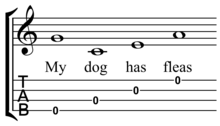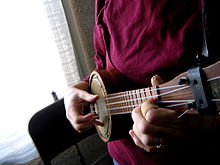Banjo ukulele
This article needs additional citations for verification. (July 2010) |
 | |
| Classification | String instrument (plucked) |
|---|---|
| Related instruments | |
| Ukulele, banjo | |
The banjolele (brand name; sometimes banjo ukulele or banjo uke) is a four-stringed musical instrument with a small banjo-type body and a fretted ukulele neck. "Banjolele," sometimes also spelled "banjelele" or "banjulele" is a generic nickname[clarification needed] given to the instrument. The earliest known banjoleles were built by John A. Bolander[1] and by Alvin D. Keech,[2] both in 1917.
The instrument achieved its greatest popularity in the 1920s and '30s, and combines the small scale, tuning, and playing style of a ukulele with the construction and distinctive tone of a banjo, hence the name. Its development was pushed by the need for vaudeville performers to have an instrument that played with the ease of the ukulele, but with more volume.
Construction and tuning

Banjo ukuleles parallel banjo construction, on a smaller scale, in terms of overall construction. They are always fretted. Most are built of wood with metal accoutrements, although the mid-century "Dixie" brand featured banjoleles made from solid metal.
The banjolele neck typically has sixteen frets and is the same scale length as a soprano or, less commonly, concert-sized ukulele. Banjo ukuleles may be open-backed, or may incorporate a resonator.
Banjo ukulele heads were traditionally made of calf skin, but most modern instruments are fitted with synthetic heads. Some players prefer the natural skin heads for a more traditional tone. The bridge floats on the head and is held in place by the tension of the strings.
Like standard ukuleles, banjo ukuleles were originally outfitted with gut strings. Nylon strings are now typically used, sometimes with a wound third string.
The banjolele is commonly tuned G–C–E–A ("C Tuning") or A–D–F♯–B ("D Tuning"), with a re-entrant 4th string. The A–D–F♯–B tuning often produces a more strident tone, and is used for this reason. Both of these tunings are known as "my dog has fleas" tunings (fifth, tonic, major third, major sixth).
Popular culture

The banjolele was the instrument played by British comedian George Formby (1904–61), who developed his own style of playing in accompaniment to his comic songs. His name is associated with the instrument more than that of any other musician.[3]
Other artists to make eminent use of the banjolele were Wendell Hall and Roy Smeck in the United States, and Billy "Uke" Scott in Great Britain.
In P.G. Wodehouse's 1934 novel Thank You, Jeeves, valet Jeeves is driven to resign over his employer Bertie Wooster's decision to take up the banjolele.
In Season 2 of Orange Is the New Black, prison guard O'Neill excitedly tells Caputo about his purchase of a banjolele. He later plays it for a group of nuns.
Queen member Brian May used a banjolele in the song "Bring Back That Leroy Brown", which appeared on their third album Sheer Heart Attack, and also to compose – but not record, he used a regular ukulele instead – "Good Company" on the Night at the Opera album.
George Harrison favoured the instrument in his later years, using it in several recordings. For example, he played it on his song Any Road.[4]
Recent users have included Jeff Claus of The Horse Flies, Alan Randall, Andy Eastwood, comedian Frank Skinner,[5][6][7]Mr. B The Gentleman Rhymer, and Steven Universe creator Rebecca Sugar. The instrument can be heard in the theme song to the television show Arrested Development.

In the 1959 hotrod-monster movie The Giant Gila Monster, hero Chase Winstead (Don Sullivan) plays the banjolele and sings, first to his handicapped little sister, and later in front of a bunch of kids at a dance, just before the monster attacks the hall.
Notable manufacturers
Historical manufacturers

- George S. Sandstrom. Oakland CA. (USA)
- Gibson Guitar Corporation (USA)
- Ludwig (USA)
- Slingerland Drum Company (USA)
- Kay / Stromberg-Voisinet (USA)
- John Grey & Sons (UK)
- Alvin Keech(USA)
Current manufacturers
- Deering Banjo Company (USA)
- The Magic Fluke Company (USA)
- Oscar Schmidt Inc. (USA)
- Recording King (USA)
- Luna Guitars (USA)
- DUKE Banjoleles (NZ)
See also
- Banjo Mandolin
- Cümbüş, A similar Turkish instrument
References
- ^ "Bolander Banjo Ukulele".
- ^ Tranquada, Jim (2012). The Ukulele: a History. University of Hawaii Press. pp. 37–39. ISBN 978-0-8248-3544-6.
- ^ Whitcomb, Ian (2012). Ukulele Heroes: The Golden Age. Milwaukee, Wisconsin: Hal Leonard Books. p. 81. ISBN 978-1-4584-1654-4.
- ^ mega. "George Harrison - Any Road".
- ^ Joanne Cole (27 July 2011). "Frank Skinner - Osama Bin Laden song" – via YouTube.
- ^ davegb99 (19 November 2011). "Frank Skinner on George Formby - Why Don't Women Like Me" – via YouTube.
{{cite web}}: CS1 maint: numeric names: authors list (link) - ^ BBC (22 September 2011). "Frank Skinner Plays the Banjolele - QI - Series 9 - Ep 3 - BBC Two" – via YouTube.
